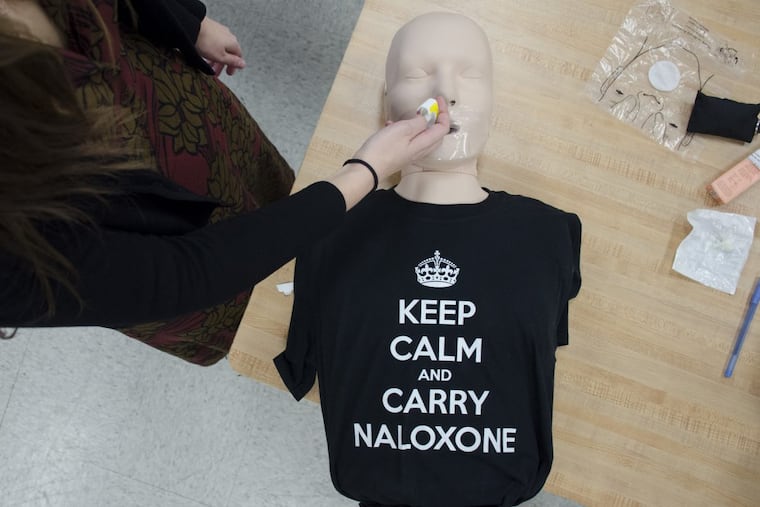I got trained to administer Narcan and so should you | Jenice Armstrong
The Philadelphia Department of Public Health will hold its next training session at 3 p.m. Friday, March 30, at 500 S. Broad St. It only takes about an hour. Try to go. Lives are stake.

So many people are dying from opioid overdoses in Philadelphia that the city has resorted to training everyday folks — people like you and me — to administer naloxone, a powerful medication that can reverse an overdose.
Think about that: Philadelphians with no medical background whatsoever are being recruited to serve as essentially emergency responders.
I have seen more than my share of possible users slumped over on city sidewalks. But beyond dialing 911, I never knew quite how to respond — until Thursday.
That's when I went to a dingy auditorium at the Philadelphia Department of Public Health offices on South Broad Street to learn about what a drug overdose looks like and how to reverse it. I couldn't have been more out of my element. I'm scared of needles. I'm a germaphobe. I don't even like getting physically close to strangers.
But after I learned of the training, I signed up immediately. I was inspired by the librarians in Kensington who keep naloxone at the ready for those who overdose at the McPherson Square branch. Last year, my colleague Mike Newall wrote about how during a visit to the library, one of the librarians ran outside with the lifesaving spray and helped a young woman who was overdosing on the lawn. I was impressed. I also figured, if she could do it, so could I.
About 1,200 people, about three a day, died from abusing opioids in Philadelphia last year. That's four times as many as those who have died from gun violence during the same period.
So, although I may be terrified of administering the drug incorrectly, I'd rather at least try to help people than let them die in front of me.
The day I went for my training, there were five of us in the class. Three guys in their 20s and an older woman. Our instructor, a social worker named Allison Herens, told us the first thing we should do when we spot someone who may have overdosed is call out something like, "Hey, are you OK?"
Herens held up a hand and demonstrated how to insert a thumb between two forefingers and do a "sternum rub" along an unconscious person's breastbone to try to get a reaction. I made a mental note but was thinking, "What if someone was just sleeping off a drunk and woke up to find my hand on their chest?"
I was relieved to learn that naloxone, sold under various brand names, including Narcan, can be easily administered as a nasal spray or as a shot into the thigh. Available at pharmacies, it can be had without a prescription.
Next, she moved on to rescue breathing. As she talked, I tried to imagine myself doing that on a total stranger. Herens must have read my mind, because she started addressing the issue: "'I don't want to put my mouth on that person. I don't know that person.' I totally get it. I have some solutions," Herens said. My eyebrows lifted as she raised her long, flowing skirt and placed it over the mouth of the mannequin to create a makeshift barrier. A T-shirt or the bottom of a paper cup also can work, Herens said. I could work with that.
Herens, whose title is harm reduction coordinator, warned that once some users are revived, they may run off. Before that happens, she suggested that we inform them that they have just received naloxone and shouldn't "use" again for a few hours.
In the job since August, she's already saved one life. It happened in September while she was at the Somerset SEPTA station in Kensington. Herens noticed a man in his late 20s behaving erratically. At first she thought he was just strange. Then, he dropped to the platform. She raced over and administered naloxone. The man quickly came around, thanked her and left.
Prevention Point, a syringe-exchange program, trains people to administer naloxone, as does the Philadelphia Department of Behavioral Health and Intellectual disAbility Services. The Health Department's next training sessions will be at 3 p.m. March 30 at 500 S. Broad St. Other dates and times are available online.
Try to go.